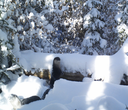
Did you get out and see the fall colors this year? Enjoy some highlights from a few of the Land Trust's Preserves.



Did you get out and see the fall colors this year? Enjoy some highlights from a few of the Land Trust's Preserves.

This month's volunteer spotlight shines a light on Jim and Sue Anderson, a powerful pair that have changed the face of the Land Trust in so many ways and who are our 2020 Volunteers of the Year!

Winter has arrived in Central Oregon! With frost on our windows, and snow covering the mountains and under our feet—the chill of a high desert winter is starting to settle in. Whether in adjusting our bodies or our behaviors, explore some of the adaptations wildlife use to stay warm in winter.

Do you have some extra time on your hands with the kids at home permanently? Check out these fun winter crafts led by Land Trust volunteer Zoe Mowry.

Take a look back at the year that was 2020. Check out some of our favorite moments in conservation as captured by our incredible volunteer photographers and others.

On December 21st, Jupiter and Saturn will appear to be almost merged from our vantage point on Earth. This is the first time in 800 years that they've been so close together and been observable.